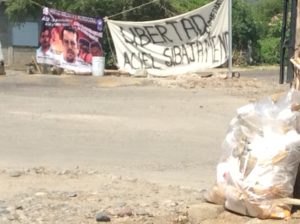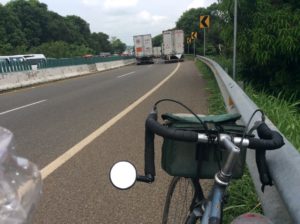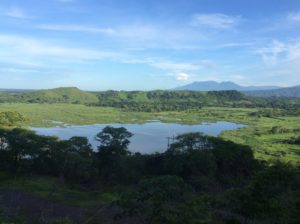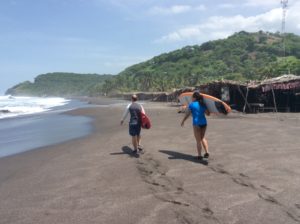July 1st, 2016


After the several days of hill climbs I took an easy day after Tehauntepec going only twenty miles to the next town, Juchitán. The topography there is coastal flats and a mix of jungle and agriculture. Ten miles from Juchitán I could see a column of black smoke coming from the town. Going into town you cross a wide, four lane bridge spanning a sizable river. On the other side sat two smoldering busses, end to end, each blocking a direction of traffic. More protests. The busses would have been set on fire about the time news of the killings in Nochixtlan reached the coast. I could see a way the bike could squeeze through around the bus blocking the oncoming traffic lane. Just then a power line that went along the left side of the bridge fell to the railing/decking. A guy on foot moving ahead of me started to turn back. The fallen wire made a ninety degree turn from a pole at the busses and crossed over them where it was burned through. It had landed on top of the bus I was headed for, but had left a way under it at the bus’s end, so I crossed over anyway. There was some steel decking that I wanted to keep the rubber-tired bike moving over, but the guy on foot was unaffected so I guess it was safe. I just wanted to get to town and duck into another hotel.
The town was completely on edge. Businesses were closed and two large grocery stores had put plywood sheets over their windows. Two hotels turned me away but I did find a decent place towards the center of town. I got groceries at a small store that kept its wrought iron gate/door locked and handed stuff through the bars. I found a bank ATM and was relieved to get some cash after not being able to in Tehauntepec.



At this point I just wanted to put distance between me and the protests. The hills/wind/road surface/ shoulder/weather stars all aligned and the next day I did a 98 mile day to Arriaga, followed by a 92 mile day to Mapastepec and then 70 to Tapachula which is then less than a half-day’s ride to the border with Guatemala. In Tapachula though, which is in Chiapas, protests were once again starting up. But everyone was all smiles, as in Nochixtlan where I first encountered it all. It had the feel of a farmer’s market with tarps and umbrellas set up among the stopped trucks. Food vendors were pedaling carts through the melee. They seemed confident in their solidarity and appeared to be more catching up on gossip than preparing for a show down.





In the last blog I had made the comment that there was probably more to the protests than what I had mentioned in a few lines. I’ve looked into it a little since and there’s a lot more. You can go here for some NY Times articles that outline some of the history. It’s a crazy world.



From Tepachula good highway takes you to the town of Hidalgo which borders Guatemala. Coming into town there are no signs for the border crossing and I had to ask instructions a few times to navigate back streets to get there. At Mexican immigration I was charged the visa “tax” for a second time because I hadn’t the where-with-all to show the receipt of having payed it when I came in to the country two months ago. One would think the visa itself (a separate document), which I had folded into the passport, would be receipt enough. After they put the charge on my credit card I produced the receipt. They shrugged “too late”. I didn’t argue. It was about $25.
Across the bridge on the Guatemala side the guard just waved me through, leaving me to think “was that ever easy.” I figured Central America must be set up like the European Union where passports aren’t checked between the internal borders.

The town there, Tecun Uman, was a border town to put behind me. I found an ATM at a convenience store and got money, a few groceries and headed to a hotel that showed on Google Earth and was about twenty miles out of town. The store had a guard armed with what’s essentially a sawed off shotgun with a pistol grip. There was a palpable military presence throughout Mexico, but Guatemala takes it to another order of magnitude- these guys and their shotguns are everywhere. If you smile and say hello they’re friendly back, but one gets the feeling that they’re not used to tourists, especially riding bicycles. Tourism, however, has become a substantial part of their GDP since the 1990s. In contrast with Mexicans, Guatemalans are a little louder and tend to heckle- though a friendly heckle- but I would also get a lot of blank stares that were hard to read. The cars got older and smokier. In the towns there are far fewer propane cookers for the taco stands and people rely more on wood burning. The air can really be bad.



Guatemala has a long history of civil and political unrest going back to independence from the Spanish in 1821. There were tough years from the 1960s to the 1990s where it endured civil war and corrupt government regimes backed throughout by the US’s CIA. After a United Nations brokered peace agreement in 1996, a degree of economic improvement followed, but just as things got rolling a new and high stakes era of drug cartels entered the picture. New era, new problems. Today, one gets the sense traveling through of extensive poverty, a well insulated, wealthy minority and a diminished middle class. Even the smaller towns would have slums right next to ultra-modern but vacated shopping malls swarming with armed guards.


The biodiversity of Guatemala sets it apart from the rest of an already incredibly diverse Central America. In the northern province of Petén the Maya Biosphere Preserve is isolated and apparently well protected as well as developed to some extent for ecotourism. The active volcanoes and mountainous area surrounding Lake Atitlán, visible from the coastal route I took through the country, has two birds endemic to Guatemala and Chiapas, the azure-rumped tanager and the horned guan. I wanted to see a quetzal as well (the bird, but it’s also their money denomination), but all were farther out of the way than I was willing to cycle.





For the route through Guatemala I hugged the mountains and never got close enough to the coast to see the ocean. I missed Guatemala City, which would have been worth seeing, but at 5000 feet elevation it would have required more grades. I stayed in inexpensive hotels for three nights but the last night before El Salvador I camped on a piece of ledge rock in an old quarry. The quarry showed up well enough on Google Earth that I pretty much new it was a likely spot and was able to plan for it. Camping on side roads and such can otherwise be pretty tough if you want to keep anonymity in a country smaller than the state of Utah and with 15 million people occupying mostly the southern third.



Rained hard that night but I was dry in the tent. I rode 8 miles into Pedro Alvarado, the border with El Salvador. I passed the immigrations for both Guatemala and El Salvador with no impediment and then found several street vendors wanting to exchange money. I was surprised when this lady gave me US dollars for a few quetzales. El Salvador and a few other Latin American countries have made the US dollar their currency to try and stabilize inflation. She was friendly and I asked her a couple of questions about the road ahead and also why it was that people just pass through the borders with almost a disappearance of the police/military presence seen throughout the countrys’ interiors. She said (all in Spanish) “oh, you have to go through immigration”.
So I walked with the bike back to the immigration line and, to make a long story short, found myself on a bus a half hour later headed back to the Mexican border to have Guatemalan immigration stamp my passport! I pleaded that there had to be another way, even suggesting a FedEx solution (of course I hadn’t seen a single one of their trucks since leaving the US). They said “your mistake”, I said “I was waved through”. How the guard could have missed the “gringo” stamped on my forehead is anybody’s guess. I pointed out to the Guatemalen side that while I was on the bus traveling back they were sanctioning my being in the country illegally. This could have back fired and landed me in jail but I was trying everything.
Once I accepted the fact that I had no choice it all went pretty smooth. I found a nearby hotel to stash the bike and got on a bus right in front 5 minutes later. The total one-way trip was about 300 miles, a small country- it could have been a lot worse. There was one transfer for which I got off the bus and into a waiting taxi to take me to another bus terminal, then was on the second bus in less than 5 minutes. There was a hotel near the bus station at the border and early the next morning a bicycle taxi took me to immigration. It took two minutes to get stamped. I walked back to the bus terminal (taking the taxi to get there was easier than asking directions) intending to have coffee and breakfast before beginning the return trip, but was promptly whisked onto another bus with a promise of coffee from the vendors that periodically get on and walk the isle. As much as I didn’t relish retracing and then re-retracing the route through Guatemala on the bike, and was grateful for public transportation, it came as a relief to get back to riding.
I’m in El Salvador now and on the ocean. I’m staying at a beach hotel, Mizata Point Resort, built and run by George Davis and his wife Wendy. George, a Californian, is in semi retirement here, though I get the impression he can’t stop working. He had lived in San Diego but said the winters were too hard. It’s a great place and I’m treating myself to a couple of day’s rest.









Hi Steve, unreal the information you have of the places you’re traveling through. Just remembering the spelling seems a task. Great descriptions ! Too bad you had to backtrack back to Guatamalan customs.. Glad you are with your bike again!
Wow, Steve! Such amazing shots, and great detail to your journey. How did that frog get in the toilet? Ride on!
….evidently up the sewer line.
Hi Steve.
It is a great story and an amaising adventure.
Glad to know you are doing well.
Enjoy El Salvador.
Regards from Navojoa.
Love your stories! Is to bad you went twice across Guatemala, hope you are enjoying your time on the adventure, my dad is here, and he said he hope the way get easy and safe! He is going back to Mexico Thursday. Take care my friend!
….Thanks Javier.
Steve, wow, so silly you had to go through Guatamala twice.
I’m so inspired by your journey. How will you cross the Panama canal?
Cassidy and mimi
…….that was silly. I was groping for the one word that could really sum it all up and “silly” really nails it. Probably by boat from Colon, Panama to somewhere on the NW coast of Columbia- the farther south the better. Too many horror stories crossing the Darien.
Hey, Steve, great to here this latest update….I’m also happy to hear you crossed the Guatemalan border successfully (well, sort of). Enjoy those rest days and keep on truckin’!
Every post I read leaves me in awe of your experiences. Recently changed my email provider and didn’t receive links for a bit, so I had to go back a read a little to catch up.
The protest stuff sounds pretty intense.
I learn so much from your knowledge of the regions through which you travel, and I am fascinated by your adventures. Look forward to more.
Steve–Your descriptions are terrific. The Nation Magazine had a story on the protests you described in your last blog. Please be safe! Take care. (See https://www.thenation.com/article/why-are-mexican-teachers-being-jailed-for-protesting-education-reform/)
You are one amazing guy, Steve.
You are on a journey that most of us could only dream of doing.
Hang in there and be safe.
What a book your posts will make.
Boone